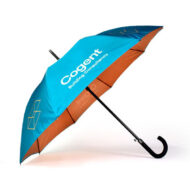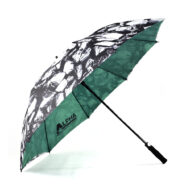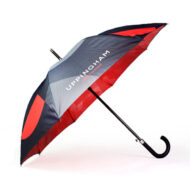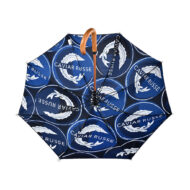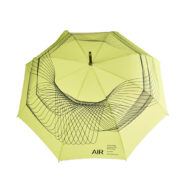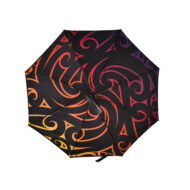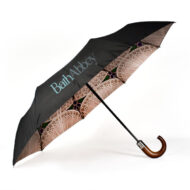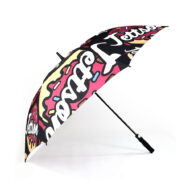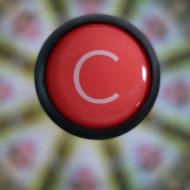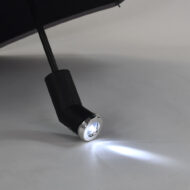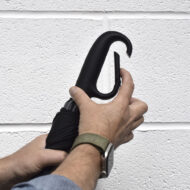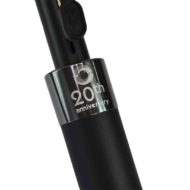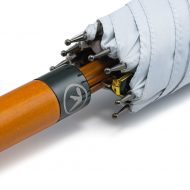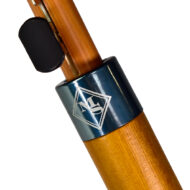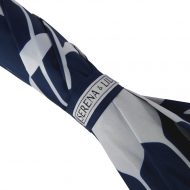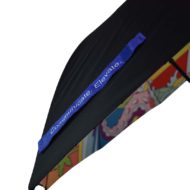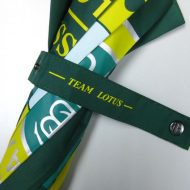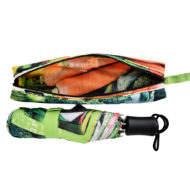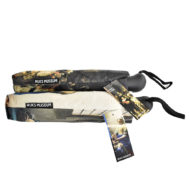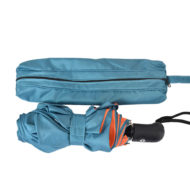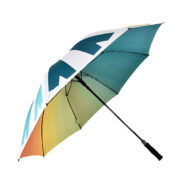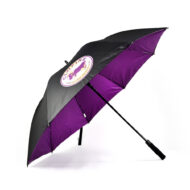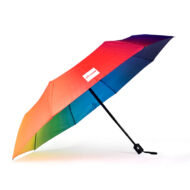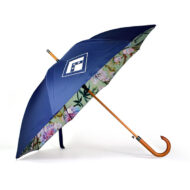Parts Of An Umbrella Diagram
A clear diagram and description of each of these parts of an umbrella to help you understand which parts can be customised and how an umbrella is made. There’s a huge range of design options available to customise an umbrella, from the outer canopy of the umbrella, to the handle ring and umbrella handle. No need to be limited by the handle on your umbrella, you can choose a curved silicon handle or a more traditional wooden curved handle. If it’s a golf umbrella you’ve chosen, a decal can be included on the base of it.
The Umbrella Workshop are expert manufacturers of umbrellas and offer a design service along with experience in customising umbrellas for global brands. Based in the UK, we’ve got a friendly team waiting to assist you.

Parts Of An Umbrella
Umbrella canopy
The canopy of the umbrella is made up of 8 panel sections, which can be printed and decorated with any design. This is the part that keeps you dry or sheltered from the sun. The canopy is usually made from pongee which is high grade polyester that is treated with an acrylic coating on the underside and a scotch-guard finish on the top. The pongee can withstand heavy rain, dries quickly, folds easily and is available in many colours. Each panel is individually cut, printed and sewn to the rib.
Digital or screen printing artwork onto the panels is possible and in most cases, happens prior to the umbrella being constructed. The fabric can also be Pantone matched and dyed prior to cutting to shape.
The external canopy is the top of the umbrella that faces the rain or sun. The internal canopy, which can also be printed or dyed, is the inside of the umbrella that the user sees when they look up when the umbrella is open. Find out how umbrellas are made by reading this blog post.
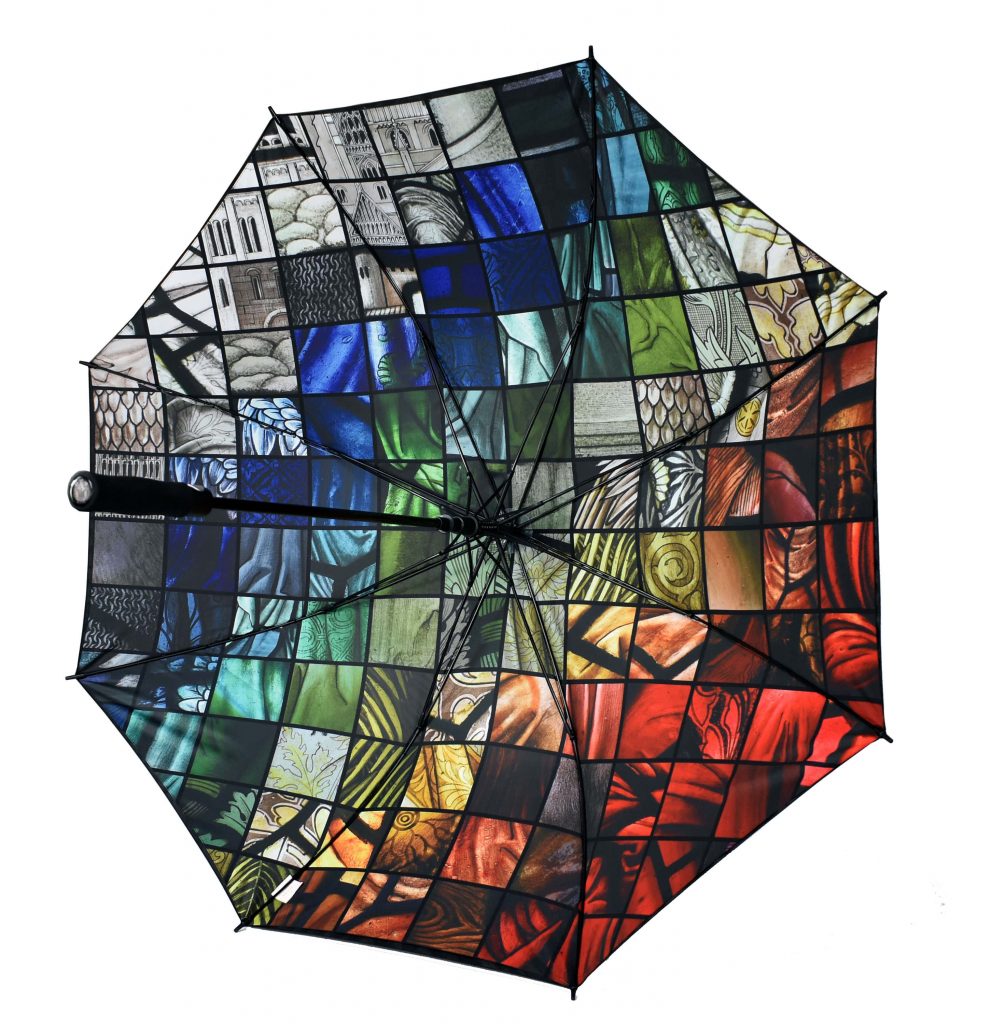
Umbrella Pole (shaft)
Once made from cane or whale bone, the shaft of a modern umbrella is now made from either fibreglass, wood, steel or aluminium. Each material has its own advantages. Fibreglass won’t rot or corrode and is extremely robust. It also holds it shape and won’t expand or contract with the cold or heat with ease.
An umbrella made from fibreglass offers longevity and won’t bend or break easily. It won’t absorb water and won’t corrode over time like steel or aluminium. Our golf umbrellas use fibreglass poles and ribs.
Wood poles are traditionally chosen for walker umbrellas and are a strong choice for an umbrella pole. Wood walkers are usually made from ash trees including Rowan wood which is common in Asia. Wood shaping machines such as lathes and turning machines create the proper shape for a pole.
Telescopic umbrellas utilise aluminium poles for a light and effective folding action. The pole of a telescopic umbrella is constructed differently to a non-folding umbrella and has three parts to it, with the two narrower parts fitting snugly inside the largest section when folded down.
Ribs
Umbrella ribs are what gives the canopy its structure and shape. The ribs closest to the pole hold up the canopy and the ribs that extend to the edge of the canopy hold the panels of the umbrella in a curved downwards shape.
Fibreglass umbrella ribs can withstand heavy usage (see how we wind test our umbrellas here).
Ribs are attached to the shaft of the umbrella by fitting a top notch (a thin, round nylon or plastic piece with teeth around the edges and held with wire). The stretchers are connected to the shaft of the umbrella with a plastic or metal runner which is what moves up and down the shaft of the umbrella when it’s opened or closed.
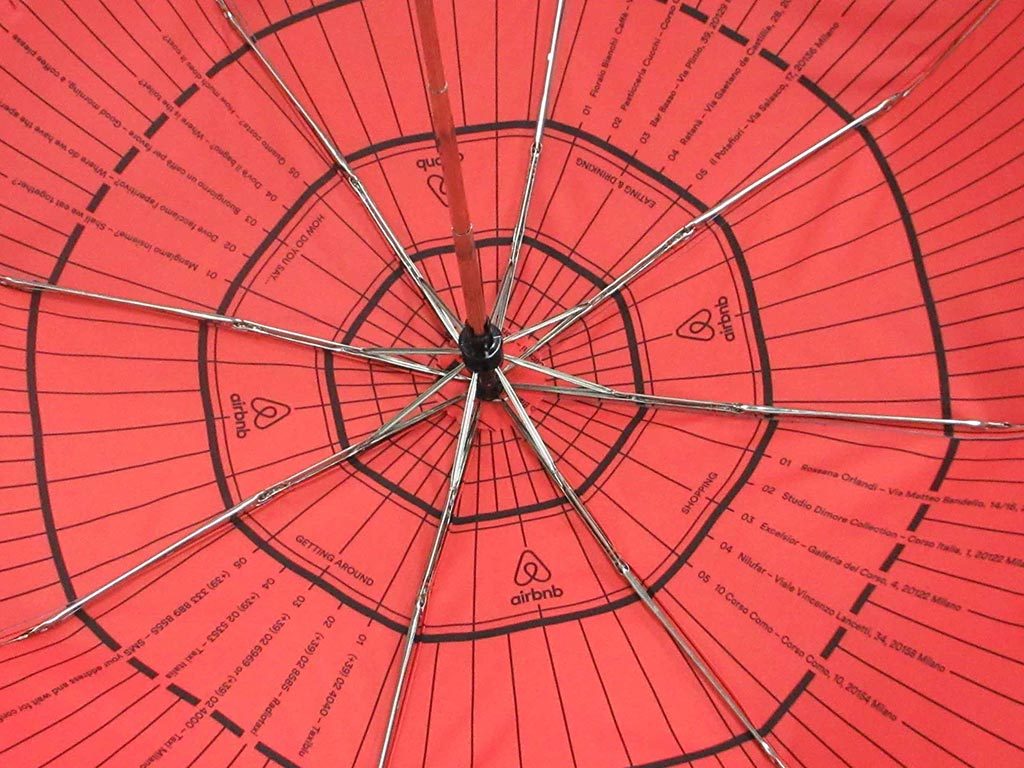
The ribs and stretchers are connected with a joiner – a jointed metal hinge that opens and closes at an angle.
Two catch springs in the shaft of the umbrella are included. When the umbrella is opened these need to be pressed and pressed again when the umbrella closes. Metal shafts are usually hollow and the catch spring is inserted. A wooden shaft requires a space for the catch spring to be hollowed out. A pin is usually placed into the shaft a few inches above the upper catch spring to prevent the canopy from sliding past the top of the umbrella when the runner goes beyond the upper catch spring.
Contact us for a quote +44 (0)1225 667979
Tips on an umbrella
The ends of the ribs that extend past the edge of the canopy are called tips. They can be left bare or covered with small plastic or wooden caps that are pushed on then screwed on, glued or sewn into the end of the ribs through small holes at the end caps.
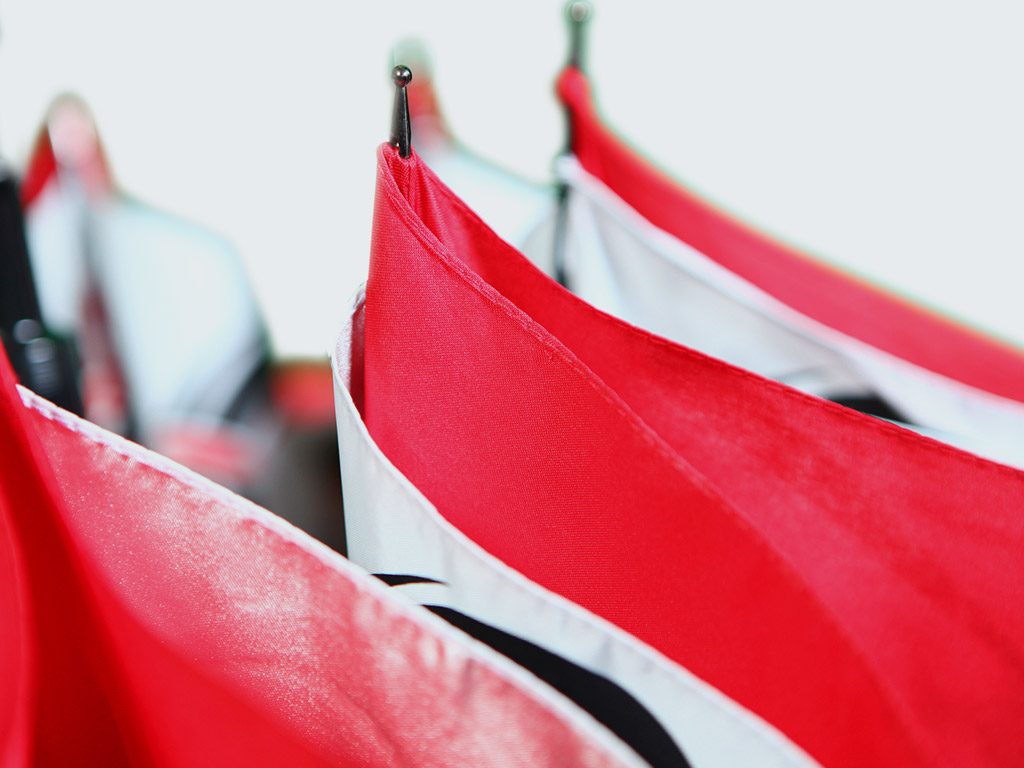
Umbrella ferrule
The tip of the umbrella, also called a ferrule can be left flat, which is usually the case with telescopic umbrellas. Or a tip can be added in accordance with the model of the umbrella. A wood walker will include a wooden ferrule with metal cover on the end. A golf umbrella will have a fibreglass tip the same as the shaft.
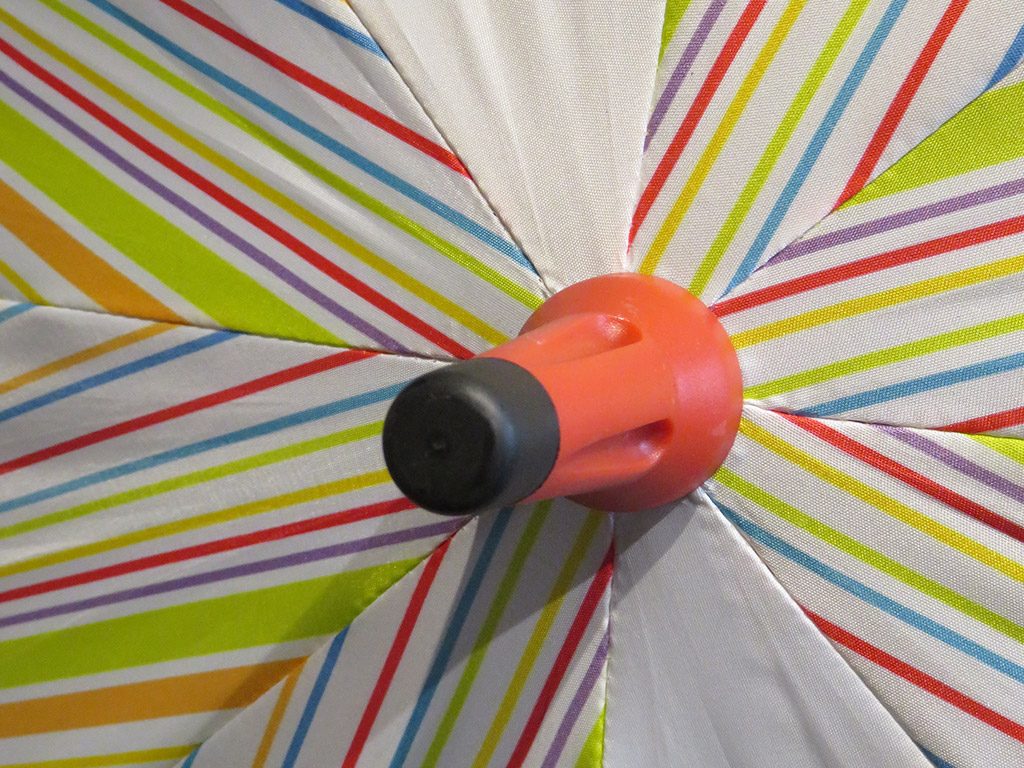
Runner on pole
The umbrella runner is the piece that moves along the shaft of the umbrella allowing the user to push up to open the umbrella and down to close it.
Customised umbrella handles
Aside from the canopy, the handle is the single most customisable element of an umbrella. It can be a crook handle, straight handle or a telescopic handle with a push button for opening.
A crook handle can be wooden or silicone for a softer feel, depending on whether it’s a wood walker or city walker.
Manual golf umbrellas have an EVA foam handle and automatic golf umbrellas have the same handle but with a push button situated above it for automatic opening.
Folding umbrellas can include a push button for auto opening. Branded logo discs can be applied to golf umbrellas and folding umbrellas.
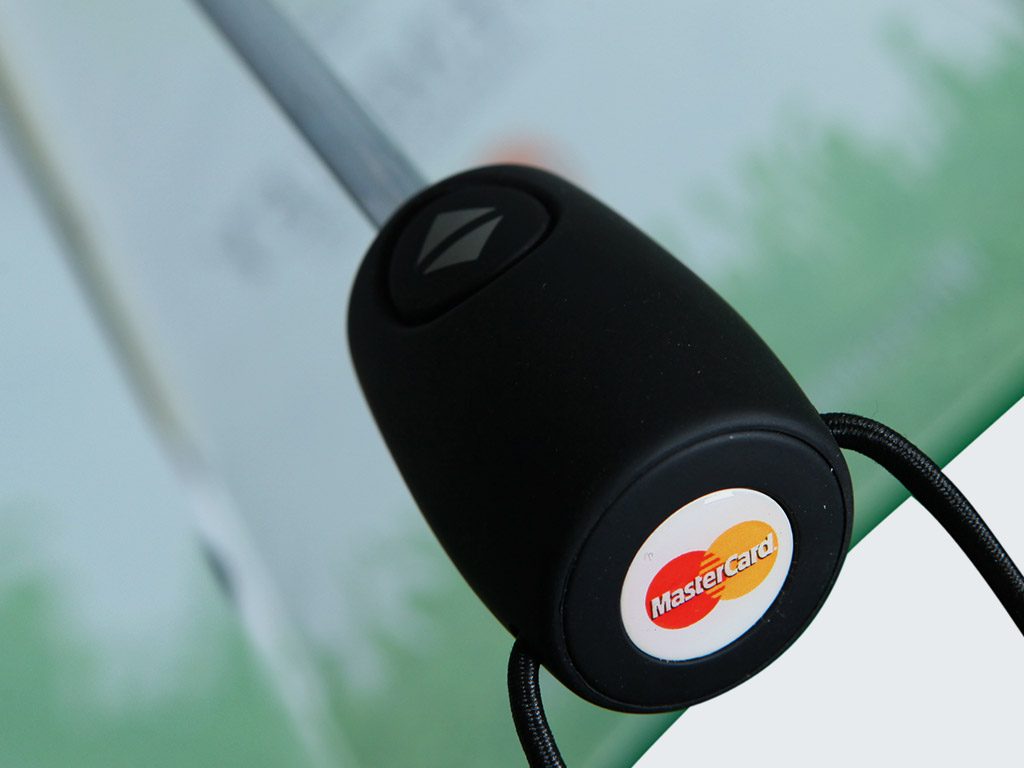
Handle ring on umbrella
Also referred to as an umbrella neck ring, this sits above the handle of a walking umbrella. It can be customised with engraving.
Umbrella handle strap
A customised handle strap can be added to any model of umbrella but is usually chosen for telescopic folding umbrellas. PU leather is a favoured material, as is polyester webbing. Handle straps are designed to fit around the user’s wrist to carry the umbrella when not in use.
Tie wrap for a brolly
Made from the same polyester pongee fabric and coming in the same colour as the panels of the umbrella, unless otherwise specified, the tie wrap is a small strip of fabric that wraps around the closed umbrella. Tie wraps usually utilise a popper to close the wrap and keep the umbrella canopy closed and tidy when not in use. A woven or printed label can also be added to the tie wrap to customise the umbrella and the popper can also be a different colour or embossed.
Carry and storage sleeve for umbrella
A protective sleeve is made from pongee, the same material used for the canopy of the umbrella. It can be printed, dyed and embroidered in accordance with brand guidelines. Telescopic umbrellas <link> are usually supplied with an umbrella sleeve to protect the umbrella when not in use and often in a bag for transporting. Walking umbrellas and golf umbrellas can also be supplied with an umbrella sleeve on request.
- Digital printed sleeve matching folding umbrella
- Printed carry sleeve for folding umbrella
- Matching umbrella sleeve
How an umbrella is made
- An umbrella is made by hand in an assembly manufacturing process. The beginning of the process involves the purchaser (client) deciding what their umbrella will look like and submitting artwork to that effect.
- The chosen model of umbrella plus artwork is sent to the production team to review. A flat layout is created for approval.
- The elements for the order are purchased including the pole, ribs, handle and fabric. Many of these items are kept in stock for regular jobs. More unusual customisation elements have to be outsourced and can take a little longer than those kept in stock.
- A pre-production sample is then created and the panels are printed in accordance with the artwork and attached to the chosen model of umbrella.
- Upon approval of the sample, the production of the whole order is created and packaged before being sent to the client’s desired delivery address.
Choosing The Umbrella Workshop for made to order umbrellas
Contact us for a quote +44 (0)1225 667979
Our range of umbrellas include three core models: golf umbrellas, walking umbrellas and folding umbrellas. Each model includes variants to suit your budget or lead time. It maybe you need an umbrella quickly and therefore we’ll offer you a UK manufactured umbrella which we can turn around within 2-3 weeks. Customisation options are limited to a logo print on a UK manufactured umbrella, but if you have a slightly longer lead time then we can print inside and outside of the umbrella. You can add a branded woven label to your customised umbrella or you can engrave a neck ring to a walking umbrella or a branded logo disk to a golf umbrella handle.
Made to order umbrellas are customised in multiple ways. From printing inside and outside of the umbrella panels and matching the seams during construction for continuous prints, to the branded tie wrap which can be embroidered or printed. The umbrella carry sleeve can be personalised with print or with a strap.
Find out how we make our umbrellas and what each of the parts of an umbrella are called with this useful article. Find out how branded umbrellas can enhance your brand.
We are specialists in branded promotional merchandise. Printed umbrellas, custom-made bags and other branded merchandise that is sensibly sourced and never single-use plastic. If you would like to find out more about how we can help your business with sustainable branded merchandise, then find out more from us by visiting Wurlin or call us +44 (0)1225 667979. We work with global clients and ship internationally.

